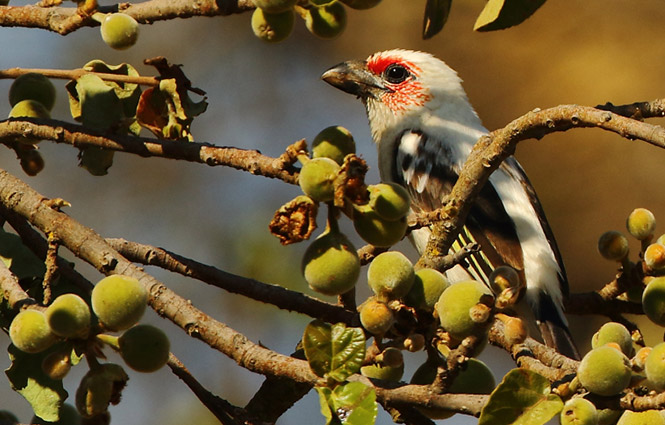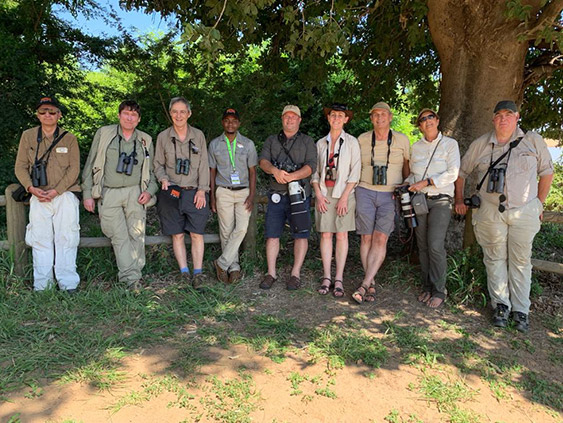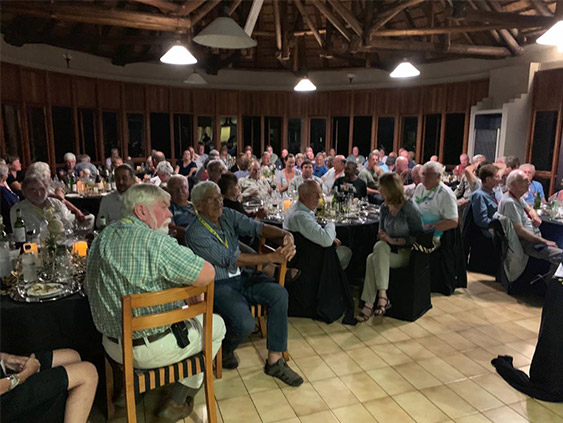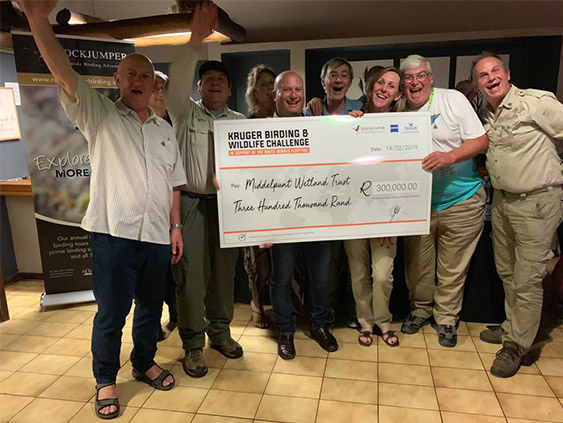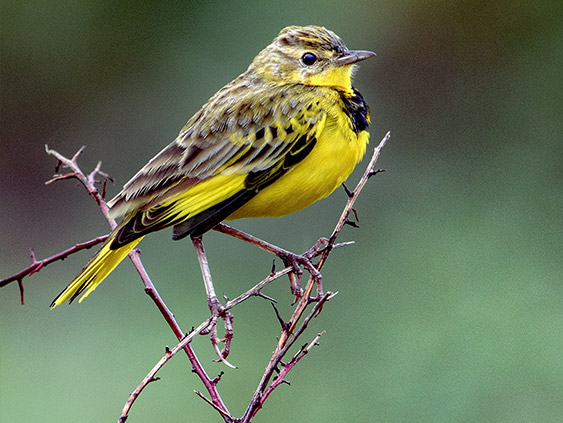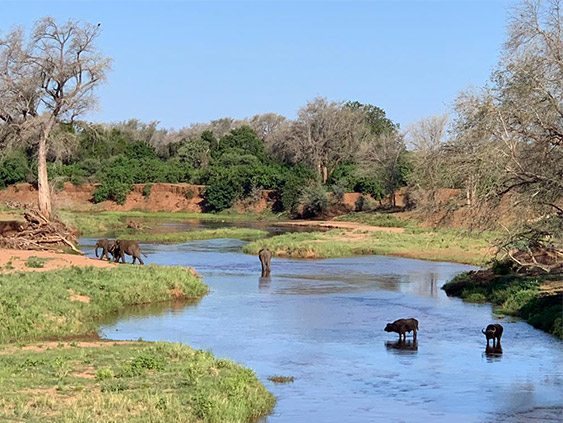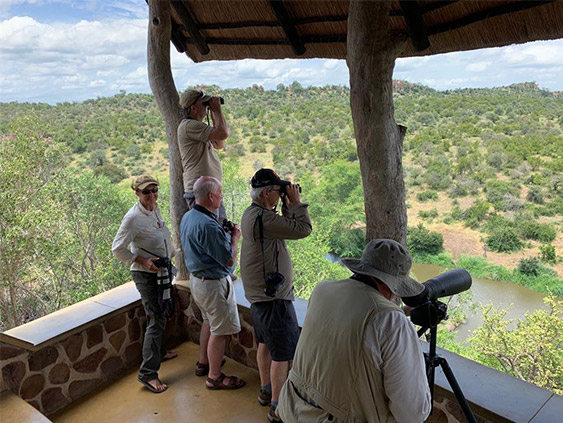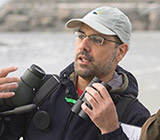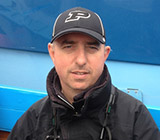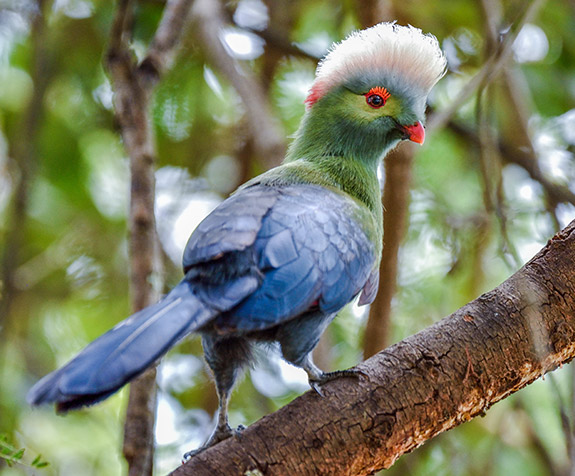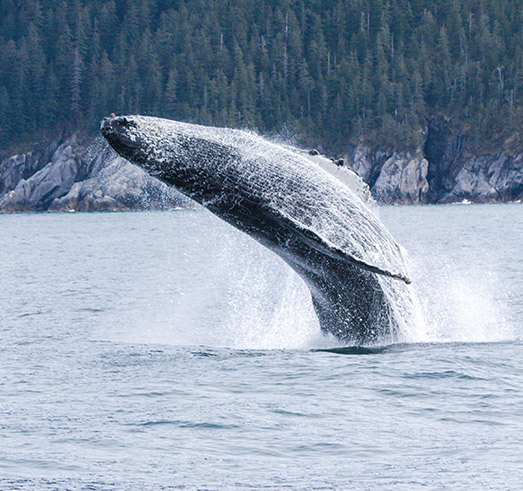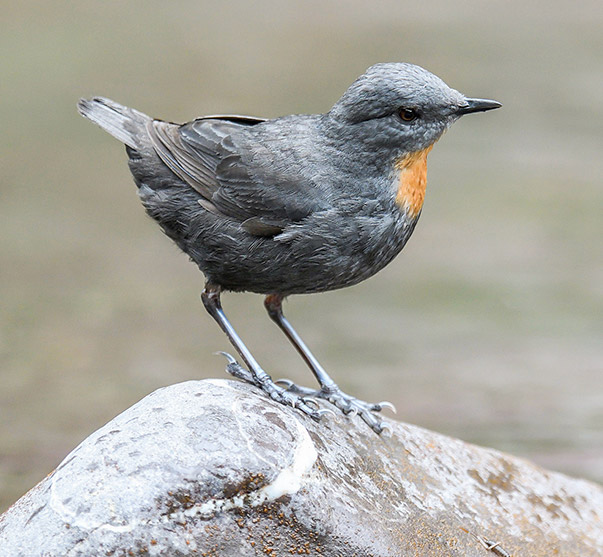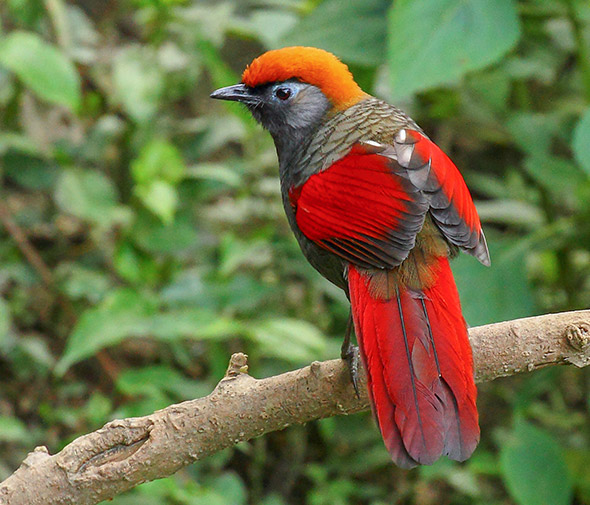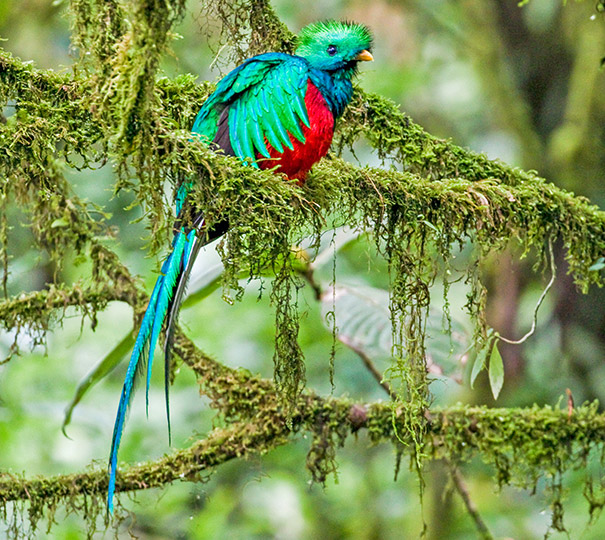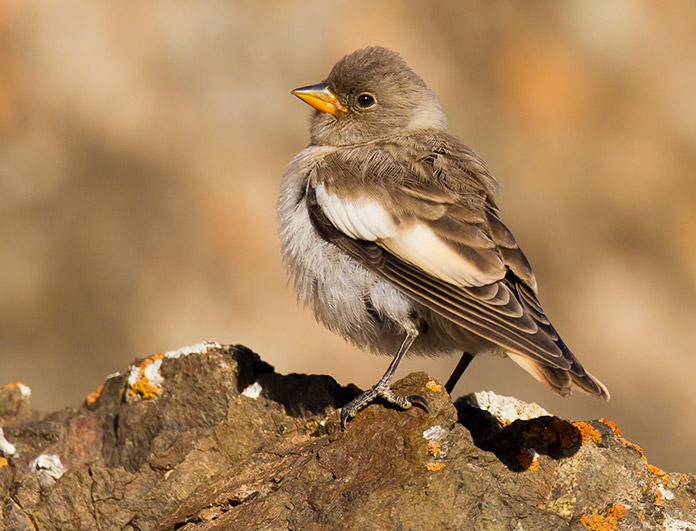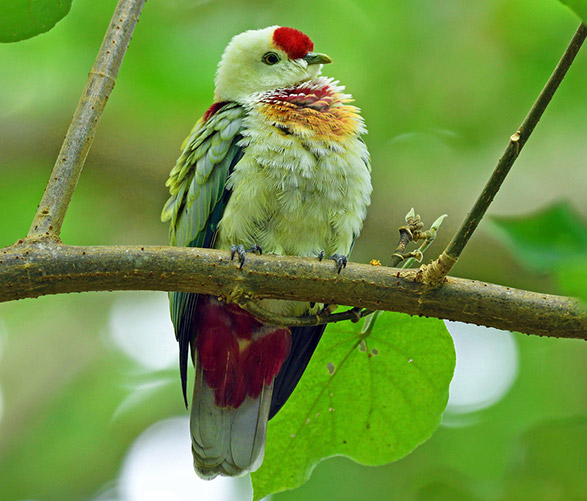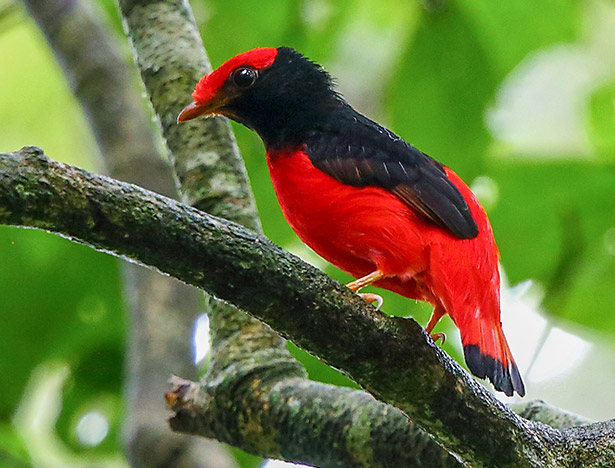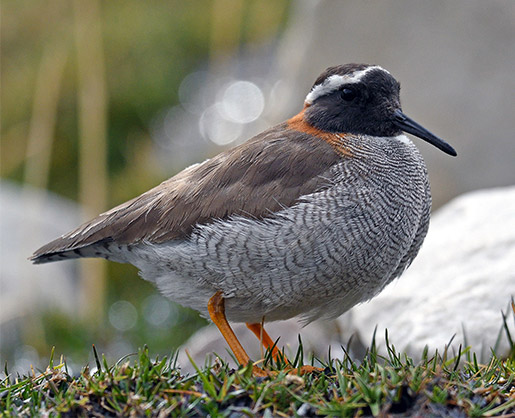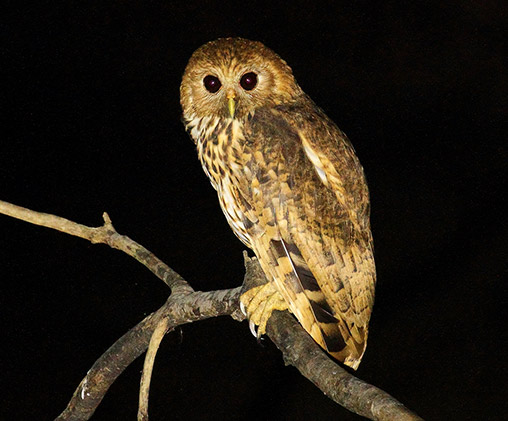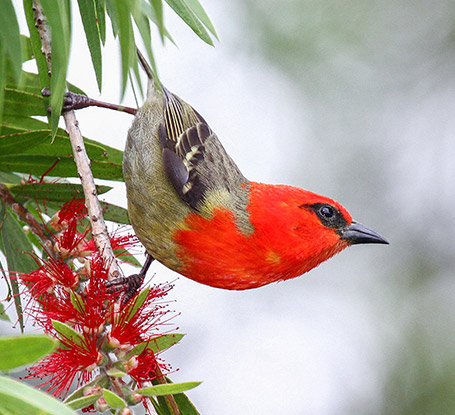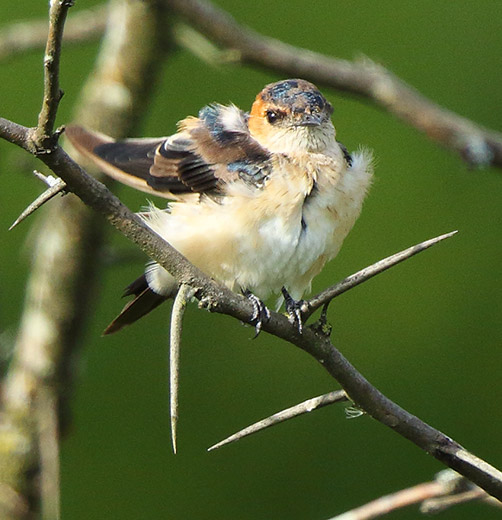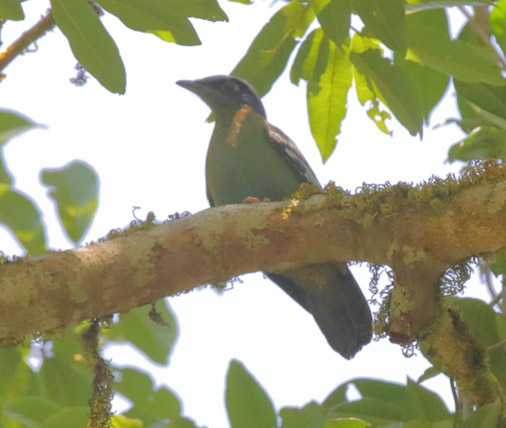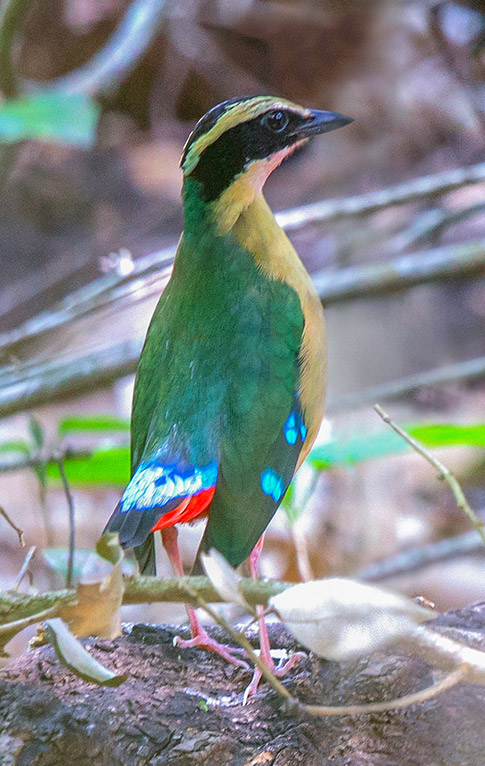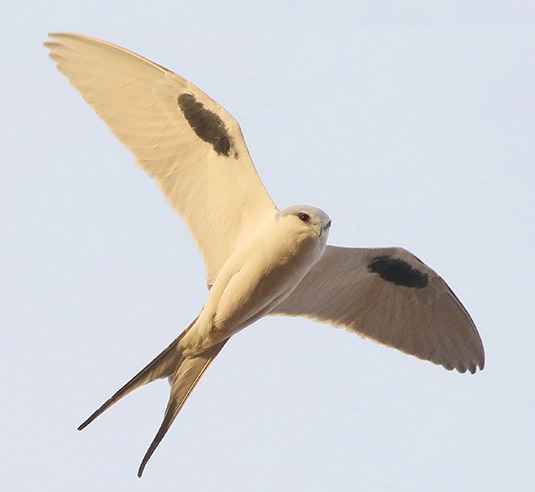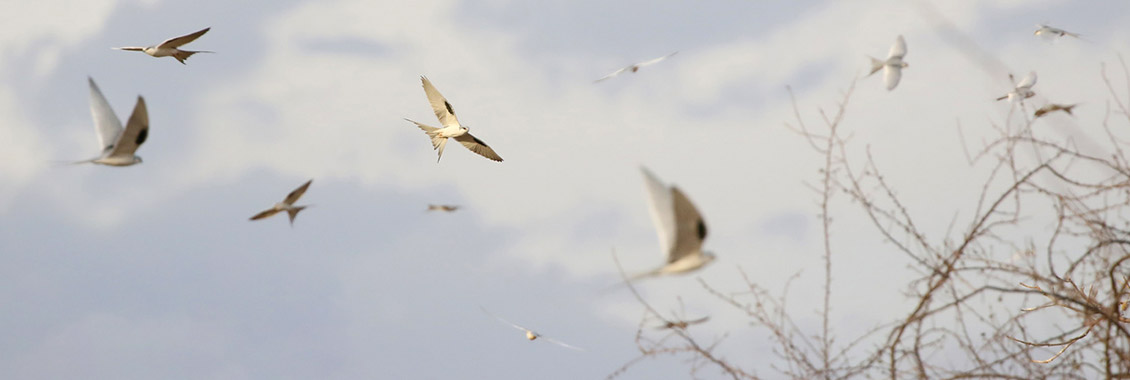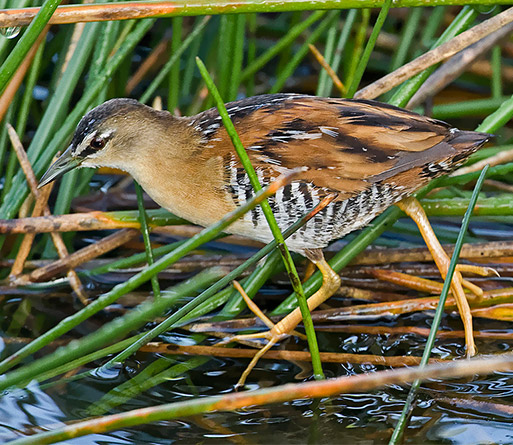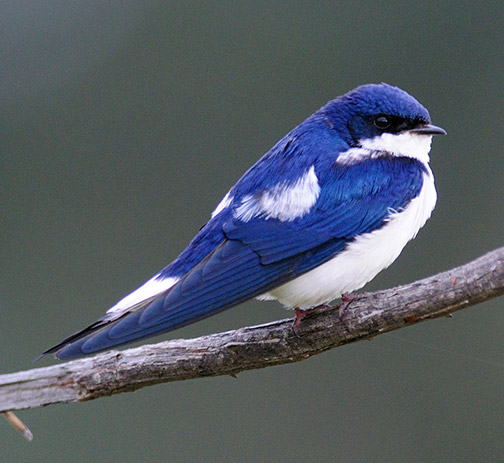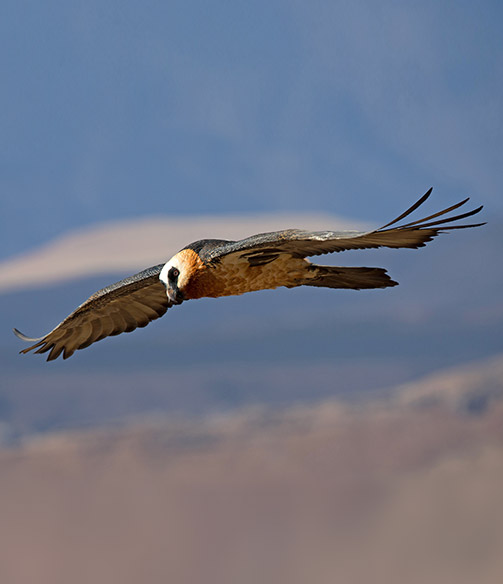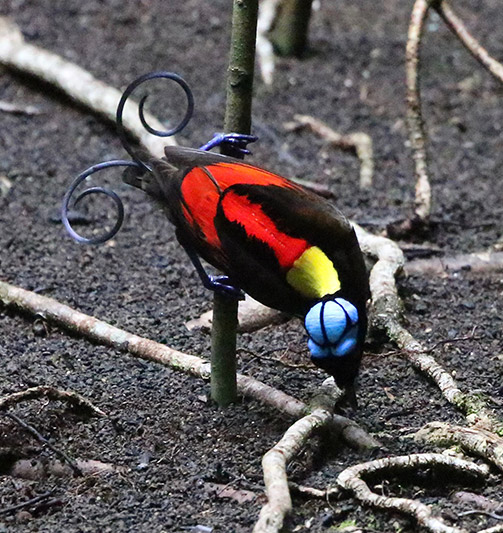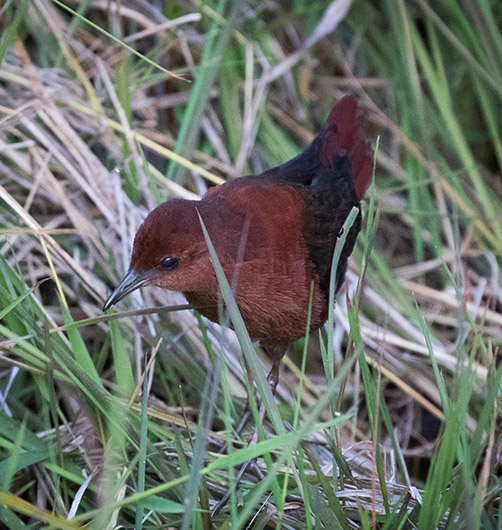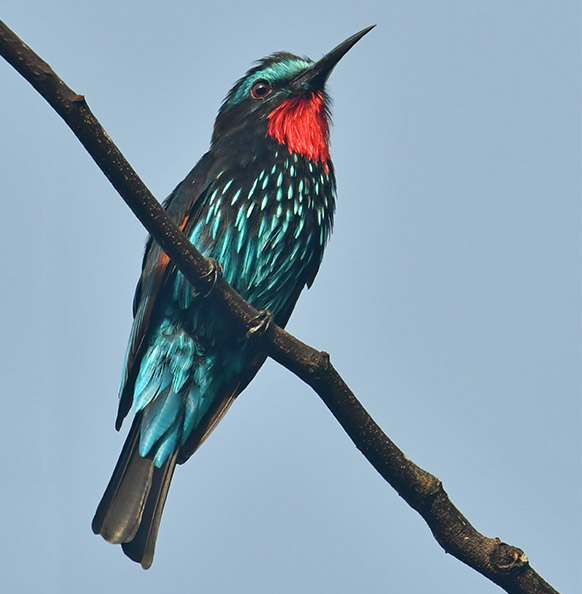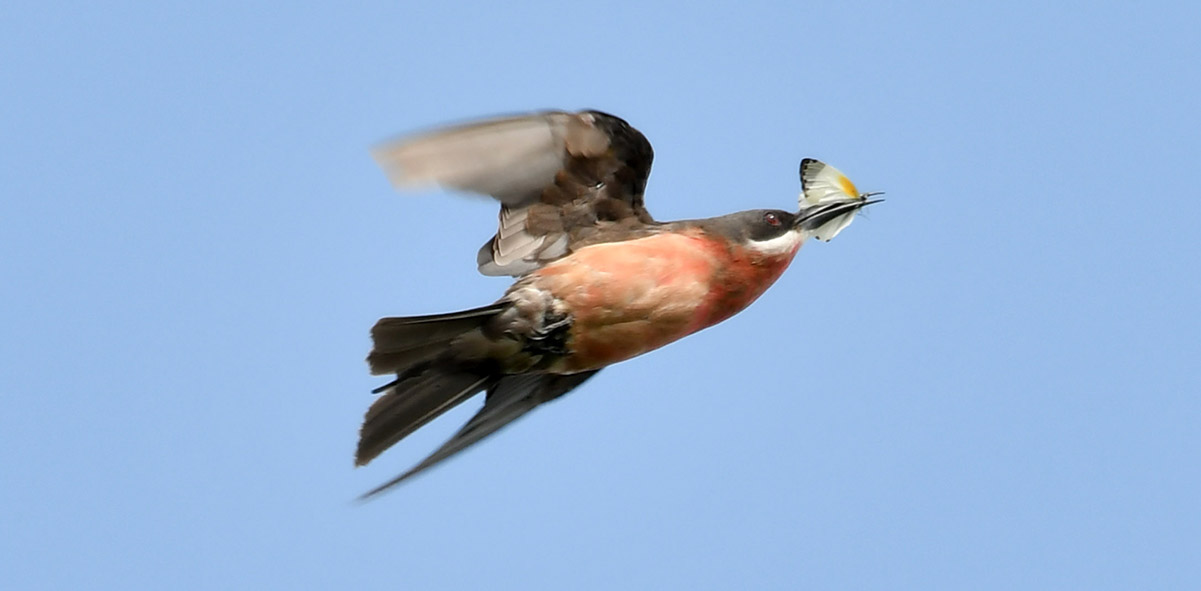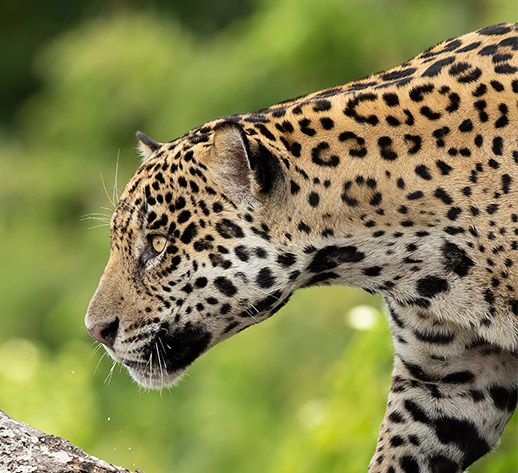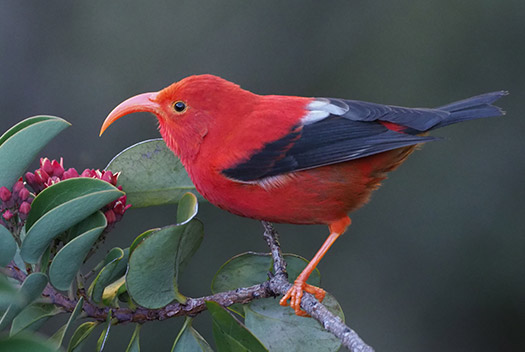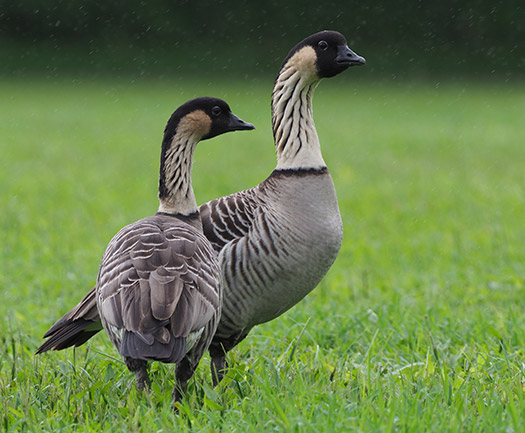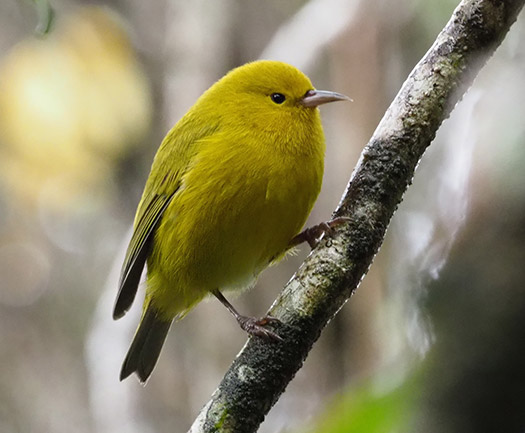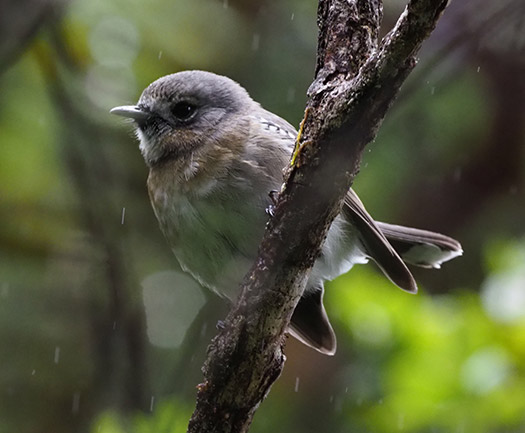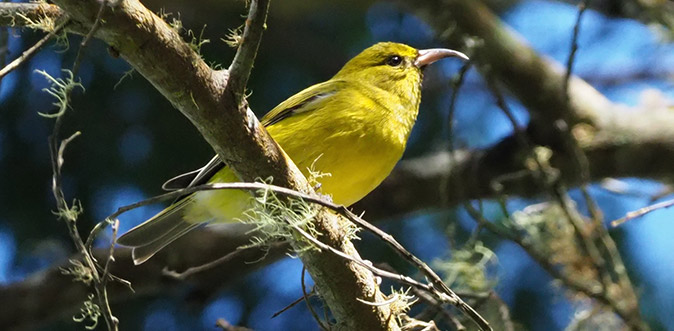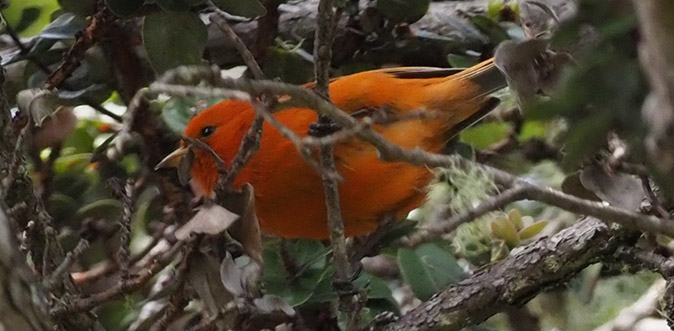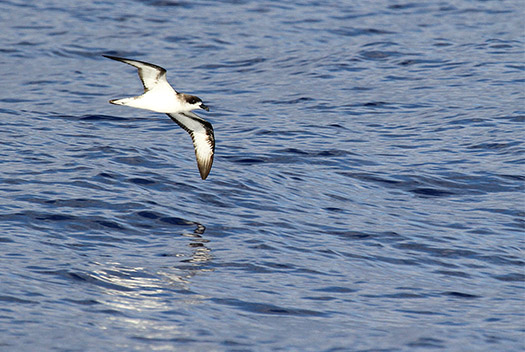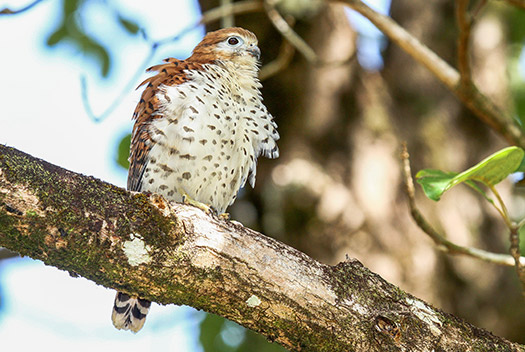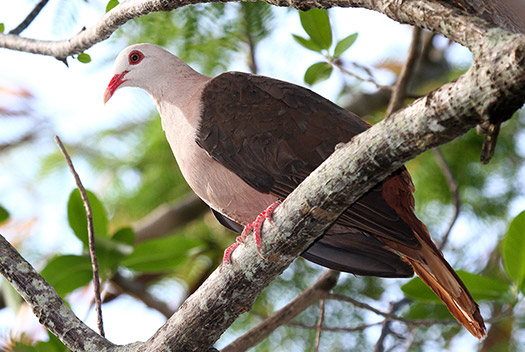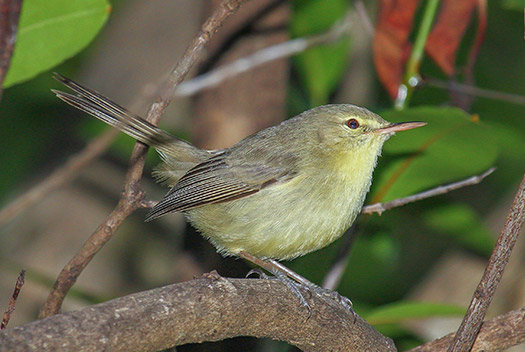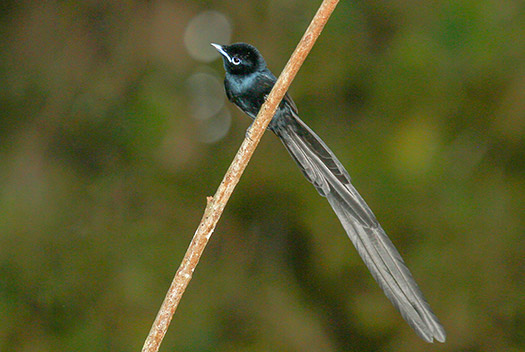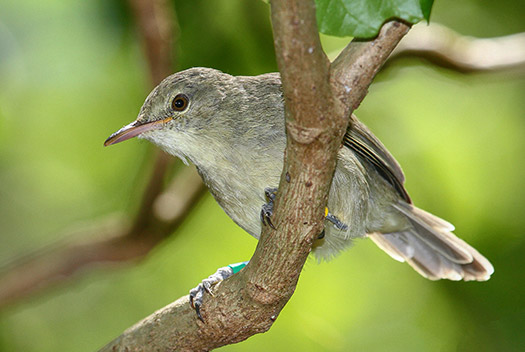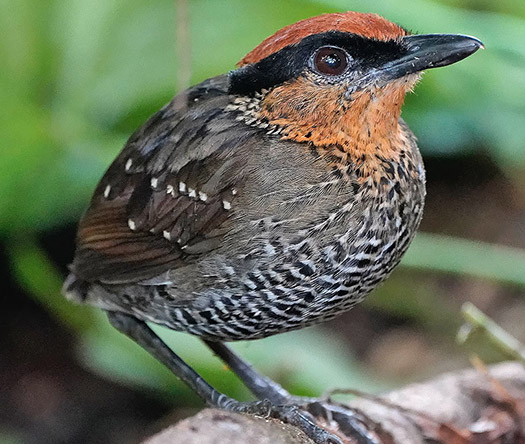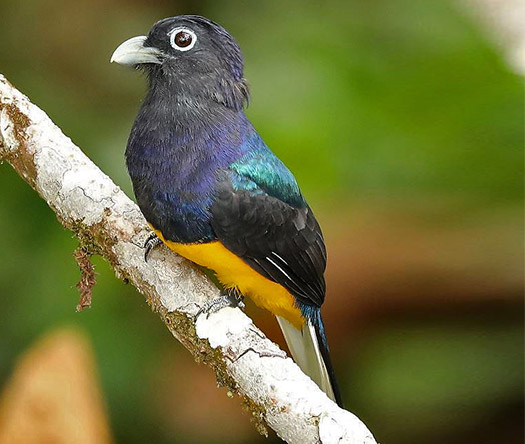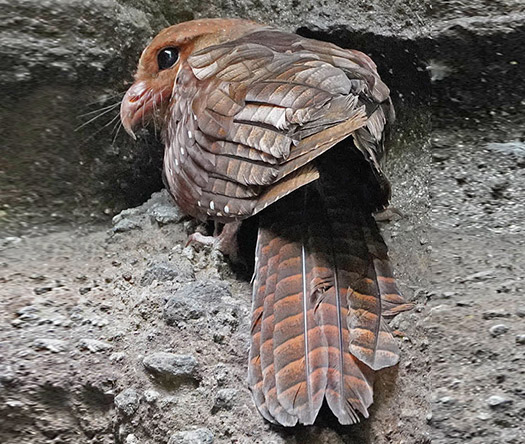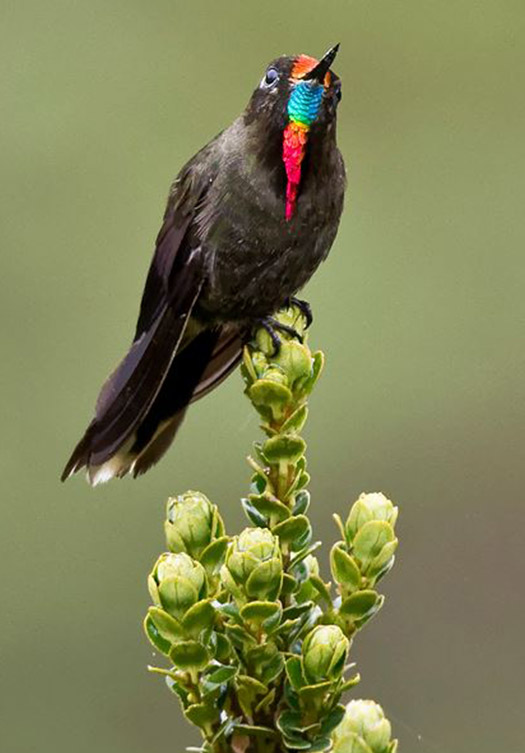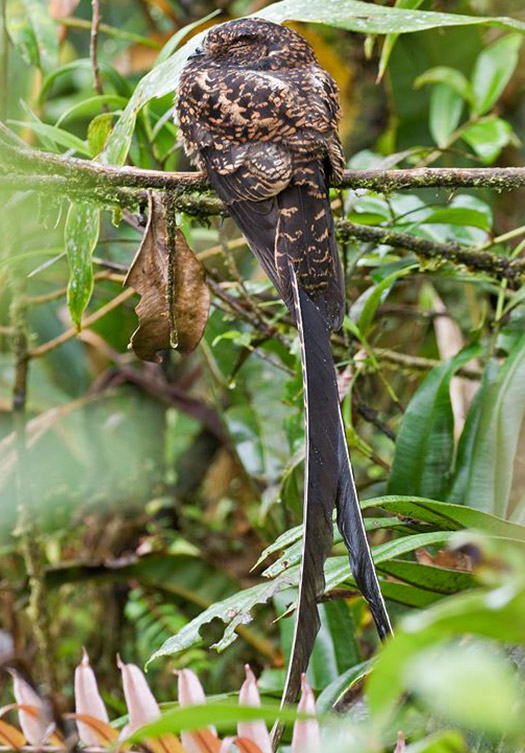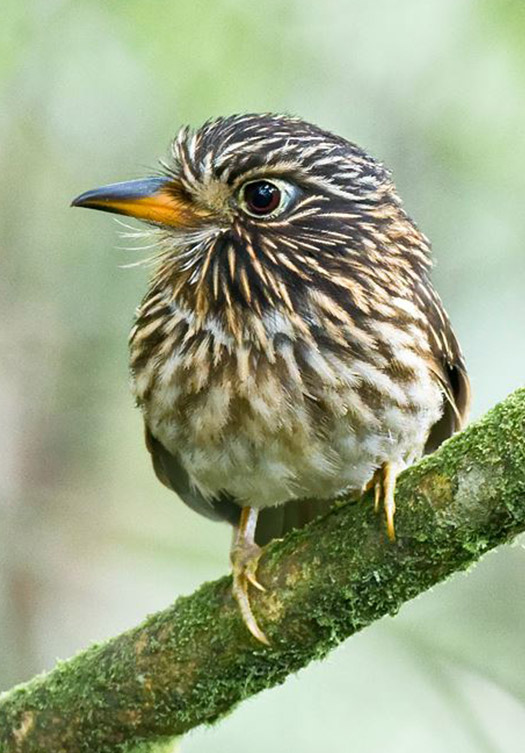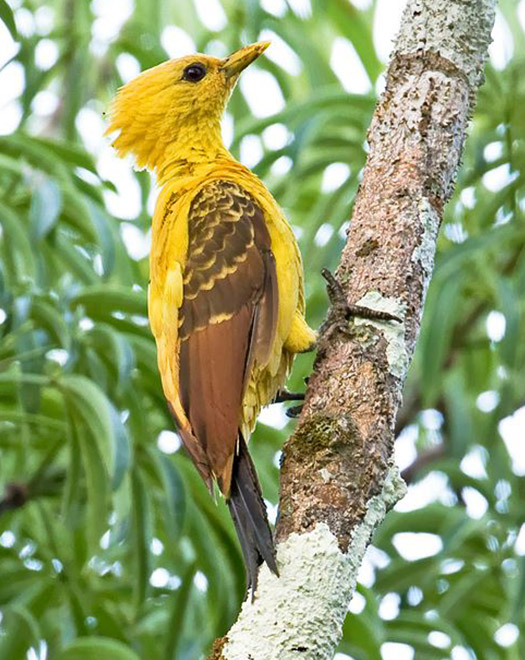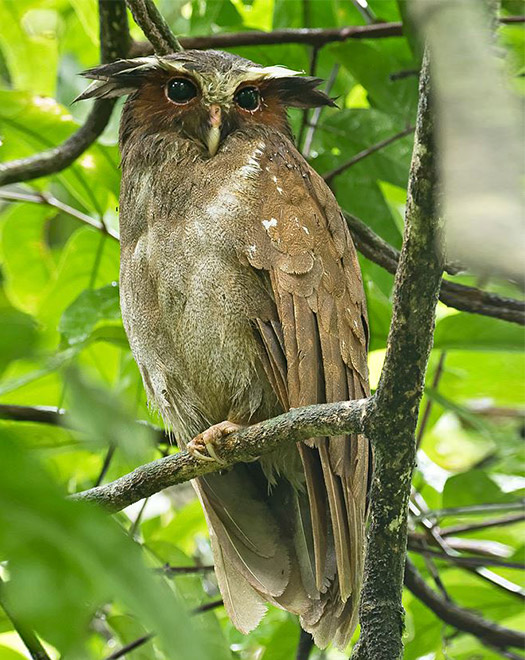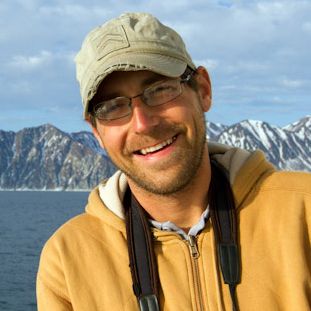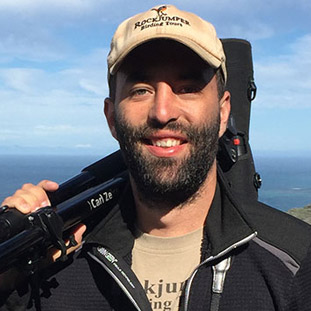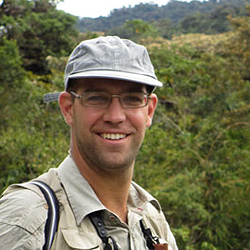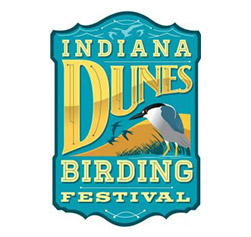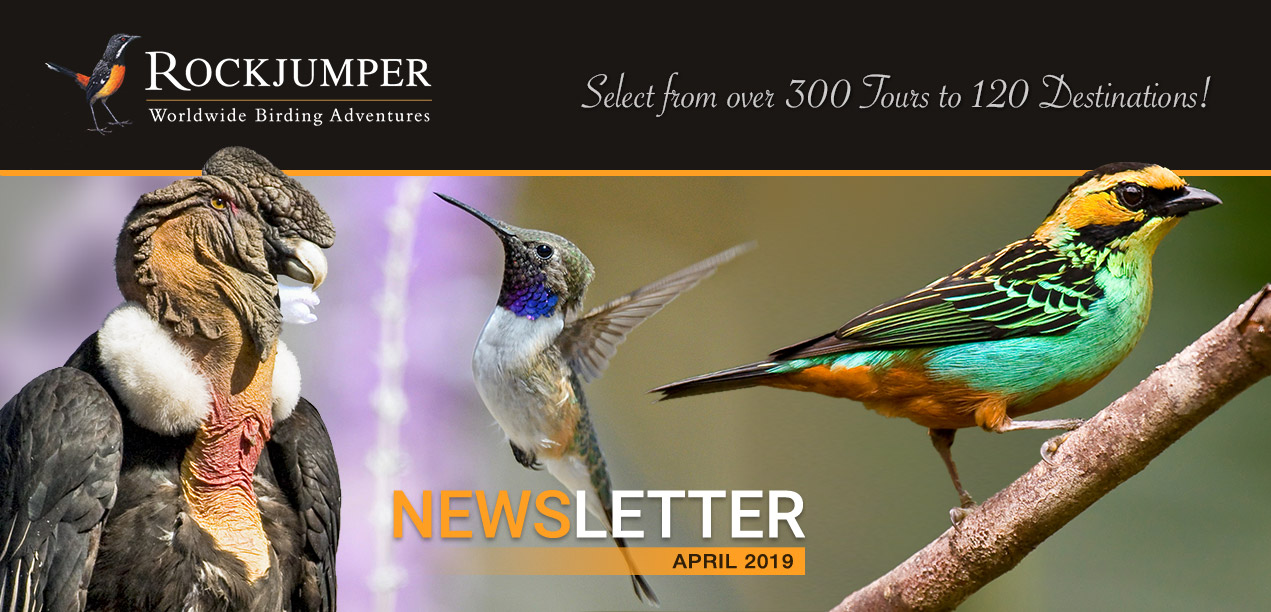
Andean Condor by Dušan Brinkhuizen, Chilean Woodstar by Rich Lindie, Golden-eared Tanager by Dušan Brinkhuizen
“TRAVEL is the only thing you buy that makes you richer.” ~Anonymous
Whether you’re enjoying the early months of 2019 in the mild Southern Hemisphere or in the harsher winter climes of the Northern, we trust your hearts are turning toward birding travel plans as we engage in one more trip around the sun. Our first newsletter of 2019 features a fresh format, new and tempting tours, and the inside story on everything from who’s “New to the Nest” at Rockjumper to the latest “Savvy Sightings” of our skilled tour leaders!
The keyword for this issue is NEW. As you daydream about your next birding excursion, we hope you’ll consider a new destination, new birds, and perhaps a new country or culture to add to your growing list! Each year brings new opportunities, and all of us at Rockjumper wish you a year full of exciting birding adventures, both locally and abroad. Now, grab a cup of tea, sit back and relax, prop up your feet, and immerse yourself in the wonderful world of birding that awaits you.
BE IN THE KNOW!
Before you go, be in the know! Here are some things that might help you as you bird your way through 2019.
My-oh-my do we have an incredible deal for you! Our friends at Bloomsbury are feeling generous and are offering ALL Rockjumper friends 15% off any Bloomsbury natural history titles, plus free shipping to any place in the world! To qualify, please use the code: BLBIRD15, at checkout. This offer is available to you through 2019, so take advantage of it while you can. Thank you, Bloomsbury, for this fantastic opportunity!
Did you know that we now feature four of our TopTours each Friday? If you find yourself unable to decide on where you want to travel to next, these TopTours are a showcase of some of our favorite and most popular tours, and this is a great place to start looking for your next birding adventure.
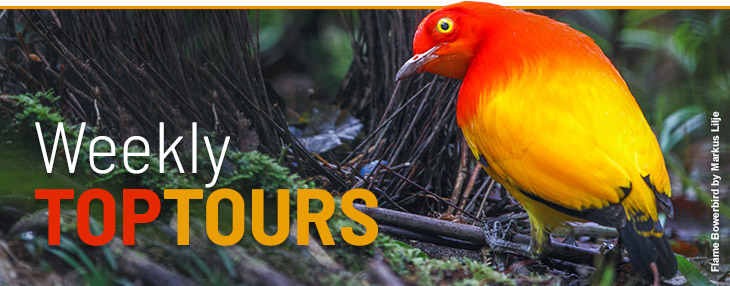
Are you ready to go at short notice? Are you interested in hearing about guaranteed tour departures? Would you enjoy receiving exclusive last-minute discounts? Then join Rockjumper Go Club! There is no charge to join, and you receive monthly updates on guaranteed tours and exclusive last-minute discounts. Sign up now and discover more!
ROCKJUMPER CONNECTIONS
Earth is our office. Around the world, every single day, the Rockjumper Team works hand-in-hand to make your birding travel experience superior. Here is some exciting news from the Rockjumper world.
Over the past twenty years, we have worked tirelessly to develop and run tours that provide our guests with incredible birding experiences. In the process, we find an impressive number of species. To prove this, we started keeping a yearlist in 2018, and far surpassed any goal we had in mind by recording an astonishing 8,064 species on our tours. Very few birders see this many species in their lifetimes, and we were very proud to have had the privilege of showing our guests over 8,000 bird species in a year. We will keep up this tradition and try to show our people even more birds this year, we’re already racing towards the 3,000 mark.


Rockjumper’s Tailor-Made Tours division has kicked off 2019 with a bang! We’re delighted to welcome new Tailor-Made team member Estel Naidoo, who jumped in with both feet in January, and is already adding incredible value to this flourishing department. We are confident that 2019 will be Tailor-Made’s best year yet as Estel and her superpowers join forces with this already-super team headed up by the ever-popular Glen Valentine.
A highlight for Tailor-Made tours during the last quarter of 2018 was the Kingsbury Namibia, Botswana and Zambia tour, affectionately dubbed “THE TOUR” of 2018! Mary Lou and her sister, Norma, spent 27 days exploring these three fascinating countries, championed by veteran tour leader, Glen Valentine. Although the tour was designed to provide a broad overview of the natural wealth of these countries, this group of intrepid birders still managed to find a vast array of Southern Africa’s most desired endemics: Bare-cheeked Babbler, Dune Lark, White-tailed Shrike, Slaty Egret, Chaplin’s Barbet and Locust Finch, to name a few! However, the mammals really stole the show, with knock-out views of Leopards (7 in total), a Cheetah with cubs, African Wild Dogs (3 separate packs, including pups), Lions, Black and White Rhinoceros, African Buffalo and African Elephant. They also encountered a range of nocturnal specialties and some very rare and handsome antelope, including Roan and Sable. All these experiences culminated to make this one of Glen’s all-time favorite trips.
In addition to this highlight tour, the Tailor-Made team completed amazing tours across the globe in Brazil, Argentina, Ecuador, Madagascar, Zimbabwe, Malawi, Ethiopia, Ghana and South Africa. Congratulations to the Tailor-Made Tours team for an exciting end to 2018, and a great start to the new year.
Design a birding tour that is the ‘perfect fit’ for you by contacting our team at tailormade@rockjumperbirding.com.
The inaugural Kruger Birding & Wildlife Challenge ran from 6th to 14th February, and was a highly successful fundraising event operated in partnership with Rockjumper and BirdLife South Africa. The concept was to run a fun challenge covering Kruger National Park from top to bottom, with teams trying to see as many bird and mammal species as possible. Each species was also allocated a score: 3 for rarities, 2 for uncommon species, 1 for commoner ones and 4 for megas. We ended up with 8 teams, with contestants flying in from all over the world. All teams were guided by great local birders who volunteered their time, and Rockjumper also volunteered its resources to set up and manage the event, with assistance from the BirdLife SA staff. We raised in excess of R400,000 (US$28,000), which will be used solely for conservation and research work on the critically endangered White-winged Flufftail. At the same time, everyone had an absolute blast. Kruger National Park was at its very best after good rains; everywhere except the far north, was lush and green. Migrants abounded and there were birds and mammals seemingly everywhere. Some teams recorded up to 200 birds on some days, as well as brilliant mammal sightings. In total, 379 bird species were recorded. The winning team was BirdLife International (with representatives from the Rare Bird Club, as well as ZEISS Optics). Captained by Rockjumper’s Adam Riley, they recorded 328 bird and 45 mammal species.
In Adam’s words: the absolute highlight for us happened less than 2 hours before the cut-off of the challenge, when our team was scouring for the last few additions to our list. Trevor Hardaker’s team, the Ayre’s Broomtails, were just a few species short and catching us quickly. The previous day had been brilliant for us, with 15 new bird species when I had only hoped for 10, but on this final day we were really struggling for anything new, whereas Trevor’s team were doing extremely well and closing the gap…. We were 10km from Mopani camp, where every team was gathering for the final banqueting dinner, when Andrew Dobson spotted a bird and asked us to back up. Once we stopped, nothing was in view, so I spished and something brilliant yellow flew in, landing right next to us. I knew immediately what it was, a Golden Pipit! This is a nomadic East African species, which is one of the most sought-after vagrants to Southern Africa, this individual being the 21st Southern African record. What a high to find the greatest rarity of the challenge at the end of the event! There was still enough time for all the other teams to get to us, so we immediately sent out word (although there was friendly rivalry between the teams, we wanted everyone to share in the sightings, and part of the contest rules were that every 3- and 4-point sighting had to be shared with everyone else). So the absolute cherry on top for us was that the pipit stayed, and all 8 teams as well as all the volunteers who assisted with the Kruger challenge got to see this bird. We couldn’t have imagined a better fairy-tale ending to a really fun event. We plan to be running the Kruger Challenge again in 2 years’ time and I cannot more highly recommend joining us for a deep-dive into the birds and mammals of the incomparable Kruger National Park.
NEW TO THE NEST
Before we introduce all the new members joining the ranks of the Rockjumper Team, we want to take time to give our warmest goodbyes and thanks to one of Rockjumper’s longest-serving Team players, Alison Wakelin. For over 14 years, Alison has played an integral role in building Rockjumper up to the place that it is today, winning massive favour with each and every person she has helped and worked with because of her keen eye for detail and unwavering commitment to service excellence. Words could never convey the level of gratitude we have for her and all that she has done. While it is tough to see her go, we know that the next adventure will see her soaring to even greater heights! From every one of us in the Rockjumper Family, we say thank you, Alison. Thank you.

New Staff

Estel Naidoo – Tailor-Made Tours Division
Estel hails from Pietermaritzburg, South Africa, with a degree in Travel and Tourism, and has worked in the leisure travel industry for over 10 years. An adventurous spirit, Estel loves to travel, and enjoys interacting with new people and experiencing new countries and cultures. In her free time, she enjoys books and movies and loves a good story. Please join us in welcoming Estel to the Rockjumper Team, where we know she will rise as a shining star.
Yaseen Rhyman
Yaseen Rhyman was born and lives in Mauritius. Before joining the Rockjumper Team, he spent 6 years working in the accounting department of a highly reputable Destination Management Company. A strong believer in the power of positive thinking in the workplace, Yaseen is a keen learner, looking to build his knowledge as much as possible while he also works to complete his Chartered Accountancy qualification. When he isn’t working and learning, you can find Yaseen going for a run, hiking or geeking out about cars.


Paul Vincent
Paul Vincent spent his formative years in the Eastern Cape, before making his way to the KZN Midlands to take up a career as a primary school teacher. After six years of teaching, he made the change to join Rockjumper as a support consultant. His cumulative years as a teacher have refined his talents as a communicator and mediator, skills which are well-suited to his new role. Outside of work, he enjoys bird photography and hiking in the Drakensberg. An enthusiastic member of the team, Paul is ready and willing to assist in any way he can.
Amar Ayyash – Part-time Tour Leader
Amar lives in the Chicago area, where his career combines his two greatest passions: teaching and birds. A well-known blogger and speaker, Amar is frequently featured at wildlife festivals doing what he enjoys most! An established gull expert, Amar has authored several technical articles on gulls and remains dedicated to various gull related projects throughout North America. He coordinates the annual Gull Frolic on Lake Michigan and serves on the Board of Directors for the Illinois Ornithological Society. We welcome Amar to the Rockjumper family, and we hope you’ll consider a tour with Amar where you will certainly learn a thing or two about gulls and much besides.
Paul Varney – Part-time Tour Leader
Paul has lived in Norfolk in the UK for over 40 years, and has been birding this British bird hotspot since the age of nine. He was the recorder for NarVOS, a Norfolk based bird club, as a youngster, and edited the Cambridge Bird Club Bulletin for several years. His career in agriculture has given him the opportunity to travel the globe, providing him with some excellent birding opportunities, including the identification of two firsts for Britain – the Holkham Red-breasted Nuthatch and the Minsmere Siberian Blue Robin. Paul enjoys sharing his passion for birding, considering it a privilege to show people new birds. We welcome Paul to Rockjumper and look forward to following his tour adventures in the coming months.
TOUR SPOTLIGHT
Make your dreams a reality! We’re shining a spotlight on one of our favorite tours: West Papua. A little-known and under-explored land that gives us access to avian wonders that few places could possibly match. If you are interested in adventure birding, it’s your time. Let’s go!
Jul 01 – 20, 2019 (20 days)
New Guinea is one of the world’s largest tropical islands, surpassed in size only by Greenland, and is blessed with an incredible avifauna, including some of the planet’s most outlandish birds. The Indonesian half of the island, the province of West Papua (Irian Jaya), is a destination few birders have visited, with large expanses of pristine habitat, from towering snow-capped peaks to huge tracts of humid lowland forest. Of particular importance to birders are several distinct mountain ranges, some of them quite isolated. This isolation has led to the evolution of a diverse and unusually interesting avifauna with numerous endemics, a significant number of which being restricted to West Papua and its offshore islands; our pioneering tour is designed to see as many of these restricted-range and endemic species as possible.
The attraction of West Papua for many is the fact that it remains relatively under-developed and primitive, and affords the intrepid birder a glance into cultures from a bygone era, having barely emerged beyond the stone-age! This does mean, however, that this tour is not for the faint-hearted and we will be camping in rustic conditions in remote areas during much of the tour. This is a small price to pay for the opportunity to see some of the most spectacular and mythical birds on the planet, including Collared Brushturkey (Brown-collared Talegalla), Snow Mountain Quail, Papuan Eagle, Claret-breasted Fruit Dove, Victoria and Western Crowned Pigeon, King-of-Saxony, Red, Wilson’s, Magnificent and Twelve-wired Bird-of-paradise, Loria’s and Crested Satinbirds, Splendid and Arfak Astrapias, Western Parotia, Long-tailed Paradigalla, Vogelkop and MacGregor’s Bowerbirds and Western Alpine Mannikin (Snow Mountain Munia), to name but a few!
To see this suite of incredible birds, you will journey with us to the spectacular Arfak Mountains; the northern lowlands bordering the Cyclops Mountains; the mysterious Snow Mountains including the upper Ibele Valley and finally the island of Biak, brimming with endemics. For those dedicated birders with a sense of adventure and a desire to see birds that few birders have ever seen, this remains one of the most incredible destinations on the planet. This strange land is sure to expose you to the avian wonders of remote West Papua, and we greatly look forward to having you aboard what is sure to be an incredible adventure!
THE NEW REVIEW
At Rockjumper, we’re always working to chart new pathways towards new birds and destinations. Check out our latest selection of new and reworked tours, and join us on these maiden Rockjumper expeditions. New frontiers await!
Ethiopia – Spring Endemics
May 25 – Jun 10, 2019 (17 days)
Spring brings earth-quenching rain, painting the spectacular landscapes in green. Spring means the Palearctic migrants have already returned home, but the essential endemic and specialty species are beginning to breed, at a time when regular tourist season is over, such that we’ll have Ethiopia all to ourselves. We also have chances for the monotypic Egyptian Plover, not possible here at any other time of year. Fascinating history, diverse cultures, and extraordinary wildlife make Ethiopia a thrilling destination for both hard-core and casual birders. Indeed, many fall in love with the country, and among your Rockjumper leaders it remains a prized destination on the African continent.
Canada – New Brunswick & Quebec:
Great Migration & Whales
Aug 23 – Sep 02, 2019 (11 days)
From scenery that is nothing short of epic to the stunning wildlife that calls it home, the natural wealth of eastern Canada is undeniable. This exclusive expedition offers a variety of snazzy migrant warblers, several boreal specialties, an array of seabirds, and possibly even the world’s largest and heaviest member of the deer family: the moose! We combine two unsurpassed natural events, with the Great Whales that have arrived at the St. Lawrence River to feed, and the passage of millions of shorebirds on the Bay of Fundy – also home of the largest tides in the world.
Argentina – North West Endemics
Jan 25 – Feb 07, 2020 (14 days)
Cordoba Extension | North East Extension
This comprehensive north-west tour is set amongst some of the most magnificent scenery in all of South America, and targets every single endemic and near-endemic bird the region has to offer! From such diverse areas as Quebrada de las Conchas and Tafi del Valle to the spectacular Humahuaca Valley and Yungas Cloud forests of Calilegua National Park, no better backdrop exists for seeking the region’s avian gems! Highlights include Rufous-throated Dipper, Tucuman Mountain Finch, flashy Red-tailed Comet, immense Andean Condor, Sandy Gallito, Burrowing Parrot, Tucuman Amazon, Lark-like Brushrunner and even Spot-winged Falconet.
Vietnam – Southern and Central Specialties
Feb 15 – 29, 2020 (15 days)
After being isolated from the world for decades, Vietnam is now a coveted destination on the world birding travel map. Encompassing all the essential sites of southern and central Vietnam, and combining this tour with the Northern Extension gives us an excellent chance of locating all viable endemic and near-endemic species. Starting in the south, we will explore highlands, lowlands and everything in between for an incredible suite of avian and mammalian specialties. This tour is for anyone with a taste for the exotic. Join us in exploring this incredible country.
Costa Rica – Budget Birding
May 01 – 11, 2020 (11 days)
The small Republic of Costa Rica has strategically and firmly situated itself at the top of the avitourism market. By developing a superb infrastructure to service the numerous visiting birders, and with over 850 bird species, staggeringly scenic landscapes, and year-round tropical climes, it is easy to understand why. A wide variety of habitats are on display, including the montane forests of the volcanic belt and the dry northern Pacific lowlands. Together, we’ll see a vast array of trogons, toucans, motmots and hummingbirds, among many other spectacular species. Thrilling birds, quality lodges, and a relaxed pace make this destination perfect for anyone who has yet to experience the wonder of Central America!
Turkey – Birding Eastern Anatolia
Jun 14 – 24, 2020 (11 days)
The size of Texas, Turkey is a spectacular avian and cultural crossroads. This fascinating nation owns an ancient history, dating back to well before Greek, Roman, and Byzantine domination, through the 500-year Ottoman Empire, and into the modern era. Needless to say, with such a pedigree Turkey offers many archaeological and cultural treasures. However, it is the birds that are of primary interest to us! As we traverse the eastern limits of the Western Palearctic, we expect to find unusual and seldom-seen species that are sure to thrill all who bear witness.
South West Pacific Islands – Samoa & Fiji
Jul 26 – Aug 07, 2019 (13 days)
A tour unlike any other, each island explored on this epic adventure exhibits its own distinctive ensemble of memorable, rarely-seen endemics, including some of our planet’s least-known species. Although these oceanic islands and their bird lists are not large, they are exceptional. Treated to a beautiful assortment of imperial pigeons, fruit doves, parrots, lorikeets and kingfishers, we will also enjoy hosts of flycatchers, monarchs, fantails, whistlers, honeyeaters, and white-eyes, all endemic to this extraordinary destination.
Peru – Central: Iquitos Endemics
Sep 12 – 21, 2019 (10 days)
Promising full immersion in the Amazon rainforest, Peru is clearly among the leading South American destinations. Our time in Iquitos will be divided between Allpahuayo Mishana, Explornapo, and Muyuna Lodge. With an area species list of over 600, we are sure to have our birding lists filled with a fantastic volume of new species! While it is impossible to know every potential highlight beforehand, we do know that this area holds fantastic opportunities for several range-restricted, endemic, and critically endangered species, as well as a slew of other fabulous Amazonian icons.
Chile – Budget Birding, Wildlife & Andean Landscapes
Nov 09 – 20, 2020 (12 days)
This budget tour covers the essential highlights of this fabulous country at a more affordable rate, while still providing numerous specialties and endemics. These range from the giant Andean Condor to the tiny Chilean Woodstar, Diademed Sandpiper-Plover and also the unique Chilean Tapaculos called huet-huets and turcas. Accommodations, meals, and wines are first-rate throughout the tour, and the Chilean people offer endearing charm and warm hospitality. From the outstanding scenery of Puna lakes and snow-capped volcanoes to the coastal desert and rich Patagonian forest, this is, without doubt, one of South America’s most memorable birding destinations.
COMING UP NEXT
Itching to travel? Daydreaming about an exciting, birdy location? Keep reading, because we’ve got some fantastic opportunities waiting for you right around the calendar-corner! These tours are filling up quickly, so sign up today.
Gabon – Rainforest Birds & Mammals
Aug 04 – 18, 2019 (15 days)
This tour takes in the bird-rich Leconi area of south-eastern Gabon, near the Congo border, as well as the fabulous Lope and Ivindo National Parks. As we search for some of Africa’s toughest and most attractive bird species, including Black-headed and Rosy Bee-eaters, Bare-cheeked Trogon, Congo Serpent Eagle, Long-tailed Hawk, Fiery-breasted Bushshrike, Shining-blue, Chocolate-backed and African Dwarf Kingfishers, African Finfoot, Black-casqued Hornbill, Finsch’s Francolin, Congo Moor Chat, Black-chinned Weaver and both Vermiculated and Pel’s Fishing Owls – to name just a handful, we will also seek out some incredible mammals, including Lowland Gorilla!
Indian Ocean Islands –
Mauritius, Rodrigues, Réunion & Seychelles
Sep 17 – 28, 2019 (12 days)
Sprinkled on the tropical seas near East Africa is a series of islands where paradise is defined! On our exploration, we will search for birds in the most spectacular scenery: forest-clad volcanic peaks, verdant forest patches and white, shell-laden beaches. Over 35 regional endemics are possible, including some of the world’s rarest birds. Our exploration of these tropical islands is a fantastic birding getaway in its own right and serves as a perfect pre-tour to the Comoros or as an add-on to our Madagascar tours. We welcome you to join us as we island-hop with binoculars in hand in our quest to find the birds of these heavenly Indian Ocean isles.
SAVVY SIGHTINGS
Our Rockjumper Tour Leaders are both fantastic guides and virtual Sherlock Holmeses of the global birding world. Sleuthing out rare birds few have ever seen, one wonders, do they have superpowers? Well, if so, they’ve got it in… flocks! “Savvy Sightings” are stories that are straight from the mouths of Rockjumper’s finest.
Adam Riley – Red-rumped Swallow
During the 3rd week of January, we held our annual Rockjumper strategy and planning session. Our senior team jetted in from around the world (George Armistead from Philadelphia, Wendy Clark from Ohio, Keith Valentine from Cape Town, Niki Stuart from Mauritius and Clayton Burne and myself from the Natal Midlands), to our inspirational destination high in the Drakensberg Mountains of Lesotho. Between our sessions, we enjoyed some great birding and found a few Lesotho rarities, such as Pale Chanting Goshawk and an influx of Black-headed Canaries – always a tough bird to connect with. However, the biggest surprise came just after we dropped Wendy off at the airport. George and I decided to visit a nearby waterworks in Pietermaritzburg. As we arrived, George joked about finding a rarity! And, sure enough, within minutes a strange swallow flew past us. Fortunately, it landed, and I was able to snap a few images, documenting KwaZulu-Natal province’s 1st and South Africa’s 3rd Red-rumped Swallow record. This widespread Asian, European and African species normally only occurs as far south as Malawi and northern Zambia.
Andre Bernon – Green Cochoa
The most memorable and bizarre bird sighting for me happened on a fantastic 14-day Thailand Highlights tour at the end of November 2018. Before we had even reached Khao Yai National Park, we had already made really good work of the areas we had birded, seeing tough species like Spoon-billed Sandpiper, Nordmann’s Greenshank, Claudia’s Leaf Warbler, Tickell’s Brown Hornbill, Ferruginous Partridge, Chinese Egret, Far Eastern Curlew and Asian Dowitcher. We had a full day to bird in Khao Yai, and while we were looking for the extremely shy Coral-billed Ground Cuckoo, a green bird flew straight over our heads, showing a beautiful black and white patterning in the wing. Luckily, it landed in a sparsely-leafed tree not too far from us, allowing us to get great looks at this notoriously difficult species to even get glimpses of!
Daniel Danckwerts – African Pitta
Pittas are renowned as one of the toughest groups of birds to connect with and, among them, African Pitta is widely regarded as one of the most elusive of them all; the species is sometimes even referred to as the ‘Holy Grail’ of African birdwatching. African Pitta occurs widely across sub-Saharan Africa, frequenting the understory of lowland thickets and rainforests. In spite of its widespread distribution, the species is rarely seen due to its secretive habits and quiet nature. The birds call for just a short period of the year, usually coinciding with the first summer rains and the start of the breeding period, after which they fall totally silent and become almost impossible to find.
After many years of wishful thinking, I finally landed an opportunity to search for African Pitta on a Tailor-Made tour through Zambia. My guests and I camped along the edge of an extremely remote ephemeral river in the Zambezi valley, near the border of Zimbabwe, for three days. Days one and two yielded nothing in the form of a pitta; however, late in the afternoon on the third day, a pitta called a fair distance away in an impenetrable thicket. After an anxious twenty minutes, the birds were coaxed closer. Using a small game trail to navigate the spiny thicket, we headed in the direction we thought the bird had called from. We sat and waited. We waited a bit more. To our surprise, not three meters away, a small shape parachuted down from the canopy. Could it be? A few more anxious minutes and the bird melted into view. Splashes of red, iridescent blue, and buff broke the swathes of endless green within the thicket. Who would believe that a second bird would then join the perch and, together, they’d sit preening for some five minutes? The sighting left us shaking with excitement, and several cold beers were enjoyed by all in celebration.
David Erterius – Madagascar Pochard
Madagascar Pochard is known as one of the rarest bird species on earth. Once believed to be extinct, the species was rediscovered at a remote lake in 2006, and it was estimated that there were only 20 pochards left in the world. Soon after, Durrell in partnership with the Wildfowl and Wetlands Trust, The Peregrine Fund and the Madagascar Government began an emergency operation to save the species from extinction. A captive-rearing project has been up and running ever since and so far a number of ducklings have been reared and released into the wild. The aim of this project is to one day return this species to other parts of Madagascar. As of November 2018, the wild population of Madagascar Pochard numbered 62 individuals.
On the Madagascar Mega tour in November last year, we managed to get to this remote lake where we spent a few hours with this highly endangered species, watching them forage, preen and rear their young. A total of 22 adults and 24 ducklings were noted by us. A true privilege, and something that yields hope for future conservation on earth!
David Hoddinott – Scissor-tailed Kite
On a recent trip to Senegal, we witnessed one of those birding spectacles that you dream about, and one which will forever stay etched in our memories. We visited a Scissor-tailed Kite roost where thousands of birds (sometimes up to 30,000) come in from all directions to roost on an island. These numbers vary from year to year, but with even 7,000 such as this year, it is quite a phenomenal experience. Watching such numbers of these enigmatic and extremely elegant raptors coming in to roost has to be seen to be believed. I had seen this species before in Cameroon and Ethiopia, but never more than 15 birds at a time, and one needs to travel to remote areas of these countries just to have a chance of seeing it. In Senegal, the sightings we had of these splendid raptors exceeded our expectations, and an added bonus was thousands of Lesser Kestrels (up to 20,000) joining them at the roost. This has to rate as one of THE great birding spectacles! Simply a must see.
Dušan Brinkhuizen – Yellow-breasted Crake
The tiny Yellow-breasted Crake has been eluding me for quite a while. It’s fairly widespread in Central and South America, but the species seems very locally distributed in most countries, and in common with many other rallids, their behavior is typically secretive. The species doesn’t seem to be as vocal compared to some other crake species, so Yellow-breasted Crake is very likely under-detected. Over the past few years, I’ve done numerous tours to Cuba but failed to pick up any evidence of Yellow-breasted Crakes. And, not to forget, the same obviously holds for the mythical Zapata Rail! In January of 2019, during our regular Cuba III tour, we heard a Spotted Rail calling from a freshwater marsh and, after some hide and seek, we got wonderful views of this very attractive bird. At the same spot, Least Bittern popped out of the reeds, and suddenly something else was flushed that surely looked like a tiny crake with yellow legs! Immediately, we carefully played the tape of Yellow-breasted Crake, and after a few minutes something responded very softly, an unfamiliar sound to me, certainly not matching Spotted Rail. We placed the speaker at a tactical opening in the marsh in the hope that it, whatever it was, would come out. After a few more minutes of silence, suddenly a tiny but strikingly patterned crake walked out of the reeds: it was a Yellow-breasted Crake indeed – an adult bird – posing only a few meters away from us! For at least a full minute, we all got mind-blowing views of this little stunner, and we even managed to photograph it.
Greg de Klerk – White-tailed Swallow
On my recent tour to Ethiopia, we set out to cover as much ground as possible in the Yabelo area. Having been restricted for birding the previous day, we had a packed schedule and needed to find as many species as possible. Yet, by midday, as we stopped for lunch our hope of connecting with a White-tailed Swallow, an endemic species with a small range in Southern Ethiopia, was fading – despite chasing every hirundine we saw in the sky. Finally, we decided to leave the area, having not found this sought-after species. As we turned onto the main road heading back to our accommodation, a swallow flew past us and, as if in slow motion, banked wonderfully to show us the diagnostic white tail. Instantly, I called all participants to me and proceeded to give horse-race-like commentary to ensure all managed a great view of this endemic. With everyone exhilarated with the experience, we returned to the vehicles and traveled happily to camp.
Heinz Ortmann – Bearded Vulture
Bearded Vulture is an incredible bird that I have had the privilege of seeing in South Africa, Lesotho and Ethiopia. Although not a lifer, on a recent private trip to Ethiopia we had amazing numbers of this species in the Lalibela area, as well as in the Simien Mountains. It was in the unbelievably impressive Simien Mountains from the lodge deck that I, along with some members of the group, experienced quite an astounding sighting. The sheer number of species and individuals of corvids, vultures and raptors in the Simiens is quite simply one of the most impressive birding experiences I have had on continental Africa. It was one late afternoon, whilst watching several species of vulture, eagle and smaller raptors that included Lappet-faced Vulture, and Steppe and Tawny Eagles through to Lanner Falcons and Thick-billed Ravens, that I noticed a Bearded Vulture carrying something whilst in flight. At first glance, it did not look like a bone, and as the bird came into better view in my binoculars, I was able to confirm that this vulture was carrying a dead young Gelada – a baboon-like primate endemic to Ethiopia! What ensued was incredible, as a pair of Verreaux’s Eagles began harassing the vulture in mid-air, all three birds twisting and turning until the vulture eventually gave up and dropped the Gelada, which was then immediately caught by the female Verreaux’s Eagle in mid-flight! The pair of eagles flew off to the cliff, out of sight and presumably to their nest, whilst the vulture continued in search of more food. This was one of many incredible experiences in the Simien Mountains, an absolute must-visit part of Africa in my view!
Nigel Redman – Wilson’s Bird-of-paradise
As the first shafts of daylight penetrated through the canopy to a small clearing in the forest, a dark shape appeared on a horizontal branch a few meters above the ground. In the gloom, the bird began to call before dropping silently down to the ground. As it moved into the gradually improving light, the black silhouette all-of-a-sudden became a riot of bright scarlet, golden-yellow, deep blue and iridescent green, topped with a sky-blue crown. It was, of course, a male Wilson’s Bird-of-paradise, arguably one of the best-looking birds in the world, and here we were peering through the holes in the blind, watching one at close range as he performed his daily chore of tidying his backyard, removing unwanted leaves that had fallen during the night. We spent the next three hours admiring this vision of utter beauty while trying to capture the moment with our cameras. A female made a brief appearance but did not stay around, and another male also showed up but was chased off. This magical treat on the island of Waigeo was the unanimous bird of the trip on our Indonesia Eastern Highlights tour, and will remain one of the best birds that any of us ever sees.
Rob Williams – Slender-billed Flufftail
Arriving in Madagascar, my most-wanted bird was the scarce Slender-billed Flufftail, but it seemed improbable, as the only area with regular recent sightings was in the remote north and not on our itinerary. Thankfully, the Madagascar Comprehensive tour that I was guiding was enjoying a great run of luck. We had seen Madagascar Snipe at a small marsh in the highlands of Ranomafana National Park, and were searching for Madagascar Rail when I spotted a flufftail’s head peeping out of some grass some 30m away. Putting my bins up, I saw it was red with a short bill and unspotted upperparts – in disbelief, I quickly encouraged the group to look. The bird dashed across a small opening and was gone, and only a couple of people had seen it. Placing a speaker a couple of meters deep in the marsh, we played the call. Suddenly, it appeared nearer briefly, but kept darting back into the dense vegetation. Eventually, we all enjoyed amazing views of this rarely seen bird just a couple of meters away in the open. It had not been recorded in Ranomafana for many years and was even a lifer for the local guide.
Tuomas Seimola – Black and Rosy Bee-eaters
One of the most intriguing bird families in the Old World are the bee-eaters, Meropidae. Most of the species in this family occur in Africa, but there are some bee-eater species in Europe, Asia and Australia as well. These birds are specialized to catch insects from the air, and seeing them hawking leaves you in awe of their agility. During my recent Ghana Comprehensive tour, we were lucky to see a total of 8 species of these aerial masters. Some of them were rare, some common, some local, but all of them very handsome birds.
In the Kakum National Park area, we had the opportunity to observe two very special bee-eater species. One of them stands out for having a name that doesn’t give nearly enough credit to its stylish plumage. Black Bee-eater inhabits tall forest and farm bush areas in Western Africa. The Rosy Bee-eater on the other hand, is a migratory bird that comes to Ghana to spend their winter in forested areas. We saw an incredible 200 birds that were gathering in a feeding area, catching mainly butterflies. These two species certainly stood out as my favorites from the 8 species we saw.
Yoav Perlman – Jaguar
While on a Tailor-Made tour in Brazil, we traveled down to the spectacular Pantanal floodplains. After a long trip from São Paulo, we arrived at Porto Jofre, the Gateway to the Pantanal, quite exhausted. Our first boat trip along the mighty Cuiaba River was wonderful, but we missed what we really wanted. However, on our second trip, we had a heart-stopping encounter with a beautiful female Jaguar resting on a large tree trunk over one of the Cuiaba River tributaries. What an awesome animal. That afternoon, we saw another two Jaguars, and over the next couple of days we encountered a total of five, despite visiting in the Low Season for them. And with days of 100+ bird species, including spectacles such as a Bat Falcon hunting a martin, Toco Toucan thrashing a Yellow-rumped Cacique nest, or hundreds of Band-tailed Nighthawks hawking over the river at dusk, our birding in the Pantanal was nothing short of brilliant.
RECENT TOURS
Every adventure has its own story to tell. Here are some tales of a few of our recent travels. We hope you enjoy them as much as we did!
Hawaii – Island Endemics 2018
The Hawaiian Islands, earth’s most isolated archipelago, host an incredible variety of endemic species that have evolved over the course of several million years. Species unique to Hawaii include mammals, hundreds of insects, freshwater fish, snails, and, of course, birds. The iconic Hawaiian honeycreepers represent one of the most fascinating examples of adaptive radiation, resulting in the evolution of around 50 species, which are now classified as finches. Sadly, introduced predators, non-native species, and diseases have led to the extinction of many Hawaiian birds, but much remains to be seen, and due to the continued threat to native birds, Hawaii represents another hotspot that should be visited sooner rather than later. I believe that watching the improbable Iiwi alone is worth the distance to get there.
Our tour in October visited three of the main islands, seeking and finding all the accessible endemics, plus a good helping of seabirds and some rarely seen introduced species that are now countable on the ABA list. We began Kauai, where we enjoyed productive wetland birding the first morning, finding the endemic Hawaiian Duck, Hawaiian Coot, and Nene – or Hawaiian Goose. We spent the remainder of the first day at Kilauea Point NWR, where we found ourselves amidst vast numbers of seabirds, revealing what these islands must have been like before human arrival. We watched in awe as Red-tailed and White-tailed Tropicbirds performed aerial acrobatics, and Great Frigatebirds hung motionless in the sky, visually stalking the Red-footed and Brown Boobies, with an eye for stealing food. Exploring the inland areas of Kauai, we went as high as we could in Koke’e SP, finding the three accessible endemics in the form of our first native honeycreepers, the Anianiau and Kauai Amakihi, plus the first Kauai Elepaio. Surprisingly, one of the most memorable birds on Kauai for participants was a group of Greater Necklaced Laughingthrushes – this species was introduced to the island but remains rare and elusive.
During our next stop on Oahu, all the birds we hoped to see fell into place, with close Bristle-thighed Curlews, the two surviving endemics, Oahu Amakihi, and Oahu Elepaio, and again some rare introduced species, most notably the Mariana Swiftlet. The final island of the tour, the Big Island, held the most significant number of surviving endemic land birds, and we had a beautiful three days here as we traversed the volcanic slopes to find them. A day spent at the Hakalau Forest Wildlife Refuge is the birding highlight of any visit to Hawaii. The refuge protects nearly all the endemics of the Big Island and offers a glimpse, and sound, of historical Hawaii’s native avifauna. Our day here culminated in an exciting hour of birding right after a field lunch. Suddenly, a small feeding flock appeared, moving quickly through the native koa and lehua trees. First, we spotted the warbler-like Hawaii Akepa, a small, crimson-colored honeycreeper that specializes in opening leaf buds. Then a Hawaii Creeper showed very well as it clambered like a nuthatch along the rough bark of the koa trees. Finally, after we had been searching all morning diligently and had only caught brief views, a pair of canary yellow Akiapolaau appeared within the flock. This is one of the most unique and endangered Hawaiian honeycreepers. We took in every detail as the pair foraged right in front of us, ending an incredible trip on yet another high note.
Indian Ocean Islands
Scattered across the western part of the Indian Ocean are a series of volcanic and coralline islands that, together, support one of the most abundant vertebrate assemblages of any island group on the planet. Of these, Madagascar is probably the most well-known, as its community of endemic land birds and mammals is comparable only to those on the islands of Borneo and Papua New Guinea. Some 90% of all species, including over 110 species of birds, can be found nowhere else on Earth but Madagascar. This is a direct result of the 165 million years of isolation from the African continent, and the complex, diverse habitat of the island itself. The isle is so unique that it has even been referred to as the ‘Eighth Continent.’ However, Madagascar’s ‘associated islands’ are fast being recognized as hotspots in their own right, with untapped birdwatching potential.
The islands of the Mascarenes (Reunion, Mauritius, and Rodrigues), Seychelles and Comoros are perhaps best-known as relaxing beach holiday destinations, for it is here that paradise is defined by coconut-fringed white-sand beaches and tall mountain peaks adorned with moss-clad humid forests. Altogether, these islands support a whopping 59 endemic bird species (likely to reach 76 in total, pending further research), including some of the world’s rarest and most sought-after birds. Among these are Seychelles Paradise Flycatcher, the unique Humblot’s Flycatcher, the once near-extinct Echo Parakeet, Mauritius Kestrel, and Pink Pigeon. There is also the indescribably rare and critically endangered Réunion Cuckooshrike (with a population of only around 30 individuals!), several jewel-like fody species, the isolated Seychelles and Rodrigues Warblers, two beautiful blue pigeons, several dazzling sunbirds, a host of white-eyes, five near-mythical scops owls and, of course, the swift-flying Barau’s and Mascarene Petrels. These islands also support several million widespread breeding seabirds, including both Brown and Lesser Noddies, White, Bridled, Roseate, Black-naped, and Sooty Terns, Greater and Lesser Frigatebirds, Red-footed, Masked, and Brown Boobies, White-tailed and Red-tailed Tropicbirds, and Wedge-tailed and Tropical Shearwaters. Some fascinating endemic mammals and reptiles also occur, including but not limited to five species of flying fox and several indescribable lime-green and red Phelsuma geckos.
I had the privilege of guiding Rockjumper’s first tour in over 10 years across this astonishing region in August/September of 2018 – split between a 12-day main tour on the Seychelles and Mascarenes and a 10-day Comoros extension. We were highly successful in locating an incredible 75 and 58 species on the central Indian Ocean Island and Comoros extension tours respectively, missing only one endemic per tour route. The main trip itself was thoroughly enjoyed by all and can only be described as a birdwatching holiday, with relaxed and leisurely visits to key sites in the mornings followed by leisurely afternoons enjoying tropical paradise; while the extension proved somewhat more physically challenging and is best suited for dedicated birdwatchers with a critical interest in future taxonomic updates.
Ecuador – Northern Suite II
Due to its vast array of habitats, ranging from the high Andes to tropical lowland rainforest, north-western South America has the highest avian diversity in the world. Ecuador is fortuitously situated within the heart of this fantastic ecological region, boasting a bird list of nearly 1,700 species! Furthermore, its small size, good infrastructure, unsurpassable scenery, and friendly people make Ecuador one of the planet’s most delightful birding destinations.
In November of 2018, we birded the north of the country, doing three back-to-back tours starting in the endemic-rich Chocó cloud forests in the west, followed by the high-elevation Páramo in the east, slowly descending through the cloud forests of the vast east-slope, and ending in the mega-diverse Amazon basin. Our fascinating journey from west-to-east was epic, and the number of superb birds and other wildlife that we saw was overwhelming. In the tropical west, a region also known as the Chocó, we got to see many endemics and regional specialties, including the rare Rufous-crowned Antpitta, Black-tipped Cotinga, Tanager Finch, Blue-whiskered Tanager and Scarlet-breasted Dacnis. Other Chocó stunners included Toucan Barbet, Velvet-purple Coronet, White-tailed Trogon, Moss-backed Tanager, and Plate-billed Mountain Toucan. Andean Cock-of-the-rock, Ocellated Tapaculo, and Oilbird were some of the more popular prize-birds that we got to see really well.
During our second week, we birded the eastern Andes from c. 14,000ft down to c. 5,200 ft elevation. Highlights included the odd Rufous-bellied Seedsnipe at the highest accessible peaks of the Ecuadorian Andes, the majestic Andean Condor and a stunning pair of Aplomado Falcons in the altiplano. A fine selection of high-elevation hummers were visible, including a cracking male Rainbow-bearded Thornbill. At the fast-flowing mountain rivers, we got to enjoy Torrent Ducks, White-capped Dippers, and the Torrent Tyrannulet. The rich cloud-forests in the region produced many exciting species, such as White-bellied Antpitta, Collared Forest Falcon, Wattled Guan, Black-and-chestnut Eagle, Barred Antthrush and several Rufous-bellied Nighthawks circling around us at dusk! A male Swallow-tailed Nightjar on day-roost was really special. Some of the colorful tangaras that we experienced in the lower subtropics included Blue-browed, Blue-necked and Golden-eared Tanagers. On the mammal front, our ultimate highlight was a Spectacled Bear that we got to watch for a prolonged time!
In the Amazonian foothills at the base of the Sumaco Volcano, we added a large number of new and exciting species to our ever-growing list: Plain-backed Antpitta, White-chested Puffbird, White-backed Fire-eye, Coppery-chested Jacamar, Lafresnaye’s Piculet, Golden-winged and Black-and-white Tody-Flycatchers, White-crowned Manakin and Military Macaw, to name a few! Hummingbirds here included Rufous-vented Whitetip, Peruvian Racket-tail, Wire-crested Thorntail, Napo Sabrewing, Violet-fronted and Black-throated Brilliants, and Gould’s Jewelfront.
Our final days of the tour were spent in the mega-diverse Amazon basin, where we birded the pristine ecosystems of the Rio Napo tributary. A variety of Amazonian habitats was covered, including terra firme jungle, varzea blackwaters, riparian forest, and the river islands. The canopy tower was especially exciting, with eye-level views of many species including Spangled and Plum-throated Cotingas, Long-billed Woodcreeper, Golden-collared Toucanet, Great Potoo, and Cream-colored Woodpecker! Some of the other highlights during our stay included the bizarre Hoatzin, the stunning Sunbittern, a crisp adult Agami Heron, a distant but identifiable Crested Eagle, the very local Cocha Antshrike, a Crested Owl on day-roost, multiple Amazonian Umbrellabirds and a cracking male Wire-tailed Manakin to boot!
TESTIMONIALS
In our high-tech, internet-driven world, the best advertisement is STILL a recommendation from a friend who’s been there and done that! When choosing your next trip, and considering Rockjumper, you don’t have to take our word for it, we’ll let our guests tell you. Here’s a little of what they have had to say recently.
Honestly, I didn’t know what to expect since this was my first birding specific trip and it exceeded my expectations. Seeing all the endemic birds, mammals and reptiles was a once in a lifetime experience I will always remember. Adam Walleyn is a great guide who is extremely knowledgeable about most things “Madagascar”. And he has balanced the skills of keeping us all on track and being fun to hang around with – so many interesting stories about his travels.
– MF, Madagascar 2018
Adam Walleyn was amazing, and we will definitely be looking into arranging a private Rockjumper tour with him in the future. Not only did he have extensive knowledge of the birds, but also the other flora and fauna, as well as some of the historical aspects of Madagascar.
– KO & MD, Madagascar 2018
All my expectations for this trip were met and exceeded, beginning with our guide Andre Bernon who is a delight in and out of the field. Fantastic birding skills and people skills, a great combination for a guide.
– DH & KH, Thailand 2018
As for the tour itself, it was excellent – Andre Bernon is a super leader, not just an excellent birder but very good with all the trip details… nothing was too much trouble. He is a thoroughly good bloke…
– CB, Thailand 2018
Doug McCulloch was great and he worked extremely hard at finding lots of birds and wildlife for our group to enjoy. He is very knowledgeable regarding the flora of each type of habitat and has excellent birding skills.
– VS & BS, South Africa 2018
Our guide, Doug McCulloch, was outstanding. Both professional and personable. He made sure we all got on the bird if possible. He has great eyes and ears, and went out of his way at times. Ie: The scope set up too high, but was the only way to see the bird. For Joanie, Doug got down on all fours and had her step up on his back to see an African Finfoot through the scope. (We have a photo of this).
– MH & JH, South Africa 2018
Dušan Brinkhuizen is a fantastic guide! He is incredibly talented as a birder but equally important, he is very patient and he managed our group perfectly. We had a great time together based on his leadership. He is an asset to Rockjumper.
– AB, Ecuador 2018
It was a well-oiled machine. Dušan Brinkhuizen is an excellent guide. It goes without saying he knows his birds and he kept the whole adventure moving smoothly. I would hope Dušan would be the guide on my next Rockjumper tour.
– DS, Ecuador 2018
Erik Forsyth is a wonderful guy, so enjoyable to travel with. He is knowledgeable, down to earth and quite humorous! We did New Zealand with Erik a few years ago and would definitely go with him on other Rockjumper trips in the future. Also, we would recommend Erik to others considering him as their leader.
– MR & MB, Australia 2018
We thoroughly enjoyed the tour, which covered a wonderfully varied range of environments, scenery, birds, etc., and was a great introduction to New Zealand. Erik Forsyth did a good job of rearranging times and/or dates for two of the pelagics, which were ultimately successful–even given substantial rain and wind.
– AW & DW, New Zealand 2018
WHERE IN THE WORLD... IS ROCKJUMPER?
Team Rockjumper turns up in some interesting places over the course of the year, from rainforests, mountains, grasslands and deserts to birding festivals, fairs, expos and events. Here are some places we’ve been recently where we’ve met some of you, and have chatted with lots of great people about the joy of global birding.
Space Coast Birding & Wildlife Festival
Titusville Florida, USA January 2019
Rockjumper is proud to sponsor this popular 20-year birding festival in Central Florida, where great birds, wildlife, and people abound! Our thanks to the Space Coast Festival team for another fantastic year in Titusville! George Armistead gave a talk about using playback to attract birds, served as a guide, and manned the Rockjumper booth. To learn more about the Space Coast Birding & Wildlife Festival, visit their website: https://scbwf.org/.
18th Annual Gull Frolic
Winthrop Harbor, Illinois, USA February 2019
George Armistead, Rockjumper’s Chief Network Officer, was the keynote speaker at this chilly-but-thrilly birding event in Illinois in February. It’s a fantastic event for all birders, especially gull-lovers and those who love birding in the US midwestern winter climate! Birders enjoy a wide variety of waterfowl throughout the weekend, with beloved highlights including Iceland (Thayer’s Iceland and Kumlien’s Iceland) and Glaucous Gulls. Along with George, Rockjumper tour leader for Japan in Winter, Amar Ayyash served as gull-chummer extraordinaire while also coordinating this exciting event from start to finish. The Gull Frolic is sponsored by the Illinois Ornithological Society, and we thank them for inviting Rockjumper to join them this year! To learn more about the Annual Gull Frolic, visit their website: http://www.illinoisbirds.org/18th-annual-gull-frolic/
WE'RE GOING PLACES
Check with your local bird clubs for birding festivals and events near you. If you happen to attend one of the following events, drop by our Rockjumper booth and say hello. We’d love to connect!
You’ll find us at these events over the next few months.

Maryland Ornithological Society Annual Conference
May 31 – June 2, 2019
Washington College,
Chestertown, Maryland
OUTRO
Wherever this message finds you, at home, at work, or outside with the birds, we hope you’ll take someone NEW birding this week and share the joy that keeps us all yearning for more!
Remember, you can easily find most of our tour information on our website’s Tour Finder, located on our website’s home page.
Thank you for traveling with us, reading along, and being a part of the Rockjumper family.
Best wishes for a happy, birdy 2019!
Yours in birding,
Team Rockjumper






